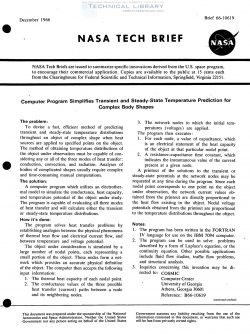NASA-BRIEF-66-10619
- Version
- 75 Downloads
- 120.67 KB File Size
- 1 File Count
- August 19, 2017 Create Date
- August 19, 2017 Last Updated
Computer Program Simplifies Transient and Steady-State Temperature Prediction for Complex Body Shapes

To devise a fast, efficient method of predicting
transient and steady-state temperature distributions
throughout an object of complex shape when heat
sources are applied to specified points on the object.
The method of obtaining temperature distributions of
the object under observation must be capable of con-
sidering any or all of the three modes of heat transfer:
conduction, convection, and radiation. Analyses of
bodies of complicated shapes usually require complex
and time-consuming manual computations.
A computer program which utilizes an electrother-
mal model to simulate the conductance, heat capacity,.
and temperature potential of the object under study.
The program is capable of evaluating all three modes
of heat transfer and will calculate either the transient
or steady—state temperature distributions.
The program solves heat transfer problems by
establishing analogies between the physical phenomena
of thermal heat flow and electrical current flow, and
between temperature and voltage potential.
The object under consideration is simulated by a
large number of nodal points, each representing a
small portion of the object. These nodes form a net-
work which provides an accurate physical definition
of the object.
A printout of the solutions to the transient or
steady-state potentials at the network nodes may be
requested at any time during the program. Since each
nodal point corresponds to one point on the object
under observation, the network current values ob-
tained from the printout are directly proportional to
the heat flow existing in the object. Nodal voltage
potentials obtained from the printout are proportional
to the temperature distributions throughout the object.
| File | Action |
|---|---|
| NASA-BRIEF-66-10619 Computer Program Simplifies Transient and Steady-State Temperature Prediction for Complex Body Shapes.pdf | Download |

Comment On This Post